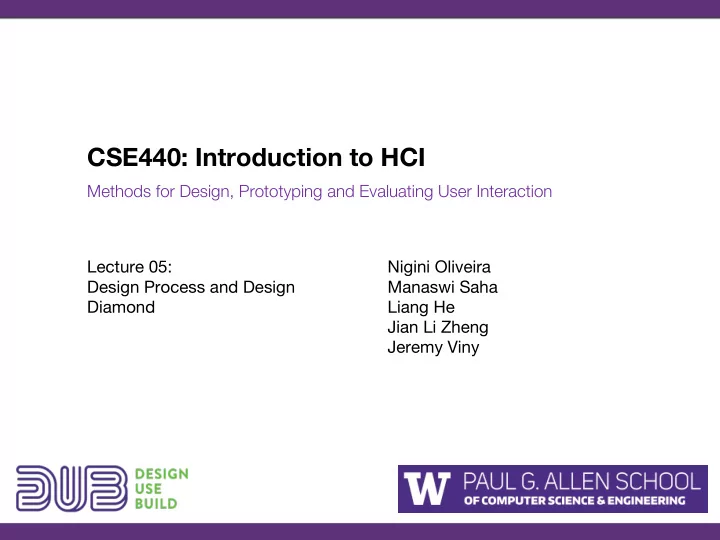

CSE440: Introduction to HCI Methods for Design, Prototyping and Evaluating User Interaction Lecture 05: Nigini Oliveira Design Process and Design Manaswi Saha Diamond Liang He Jian Li Zheng Jeremy Viny
What we will do today Design Process and Design Diamond Sketching Creativity
Design Process in a Nutshell
Getting the Right Design
Design Process in a Nutshell
Design Process in a Nutshell
Design as a Choice Elaboration Reduction palette of choices heuristics to choose
The Design Diamond danger! danger! start generate select danger! intentional! danger!
Critiquing design ideas is important Ideas are both good and bad Both are useful in design By making clear what is a bad design, we can avoid actually implementing it Bad ideas help you justify your good ideas Feedback can turn a good idea into a great idea
Idea Oscillation Critique Critique
Iteration Toward a Design
Exploration of Alternatives
The Converging Path
Let ideas oscillate... The fourth generation of the iPod was successful
Sketching as a way to boost creativity
Sketching
Sketching
Sketching
Sketching A process that enables you to think through ideas and convey design ideas to others very early in the design phase
Sketching = Quintessential Activity of Design http://payload70.cargocollective.com/1/8/259486/3705937/mouse%20sketch%201.62_2.jpg
Properties of sketches Quick Distinct Gesture Timely Minimal Detail Inexpensive Appropriate Refinement Disposable Suggest and Explore Plentiful Ambiguous Clear Vocabulary
Quick A sketch is quick to make, or at least gives that impression
Timely A sketch can be provided when needed
Inexpensive Cost must not inhibit the ability to explore a concept, especially early in design
Disposable If you cannot afford to throw it away, then it is not a sketch But they are not "worthless"
Plentiful Sketches do not exist in isolation Meaning and relevance is in the context of a collection or series
Clear Vocabulary The way it is rendered makes it distinctive that it is a sketch (e.g., style, form, signals) Could be how a line extends through endpoints
Distinct Gesture Fluidity of sketches gives them a sense of openness and freedom Opposite of engineering drawing, which is tight and precise
Minimal Detail Include only what is required to render the intended purpose or concept
Minimal Detail
Appropriate Degree of Refinement Make the sketch as refined as the idea If you have a solid idea, make the sketch look more defined If you have a hazy idea, make the sketch look rougher and less defined
Suggest and Explore Rather than Confirm Sketch should act as a catalyst to the desired and appropriate behaviors, conversations, and interactions
Ambiguity Intentionally ambiguous Value comes from being able to be interpreted in different ways, even by the person who created them Sketches have holes https://www.deviantart.com/tomalex123/art/Holes-sketch-298354319
Sketching as Conversation Mind Sketch knowledge, representation new knowledge
Sketch vs. Prototype Sketch Prototype Invite Attend Suggest Describe Explore Refine Question Answer Propose Test Provoke Resolve Tentative, non committal Specific Depiction The primary differences are in the intent
Beyond sketches on paper…
Physical sketching
Physical sketching Mueller, WirePrint, UIST 2014
Lets try it!
Sketching exercise Part 1 (3 minutes) by yourself, sketch at least 5 new designs for a cup when you are finished, pin them to the wall
What are the dimensions of this design space?
Sketching exercise Part 2 (6 minutes) throw out your old ideas and sketch 10 new cup designs following the different design dimensions
What was your experience?
Design Ideation People become fixated in their design ideas. Examples can lead to reinterpretation and recombination of ideas. Defining the solution space increases people’s creativity. http://paotodo.com/pdf/siangliulue_timely_examples_cc2015.pdf
Creativity
More Evidence
More Evidence
Quantity versus Quality Pottery study: One class was told they will be graded on quality, another one on quantity
Quantity versus Quality The quantity class produces better pots. Why?
Quantity versus Quality The quantity class produces better pots. Why? “While the quantity group was busily churning out piles of work—and learning from their mistakes—the quality group had sat theorizing about perfection, and in the end had little more to show for their efforts than grandiose theories and a pile of dead clay”
More Evidence Task: Create a web banner ad for Ambidextrous magazine.
More Evidence prototype prototype prototype feedback prototype prototype feedback feedback feedback feedback prototype feedback prototype prototype prototype feedback feedback prototype feedback feedback final final Parallel condition Serial condition Dow et al. TOCHI 2010.
More Evidence FINAL serial prototyping condition parallel prototyping condition
More Evidence FINAL serial prototyping condition parallel prototyping condition The parallel prototyping condition also led to significantly higher click-through rates.
Summary Greater divergence in designs Prevents sticking with the first idea Allows mashing ideas together Alternatives facilitate feedback Enable comparison Can improve tone of critique
So how do people do this in practice?
Ask me something!
Recommend
More recommend